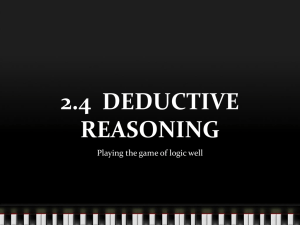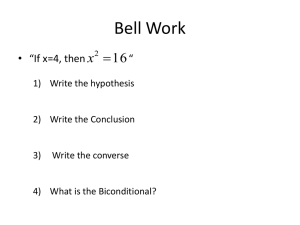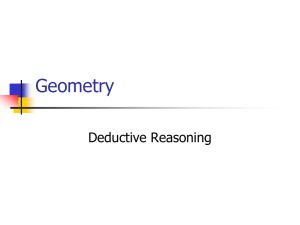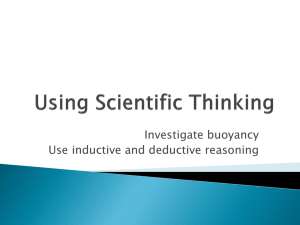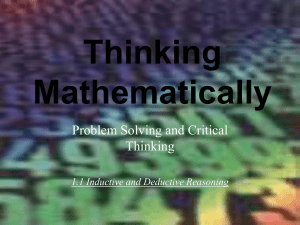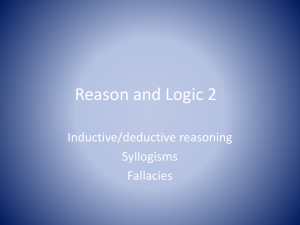2-4 Deductive Reasoning
advertisement
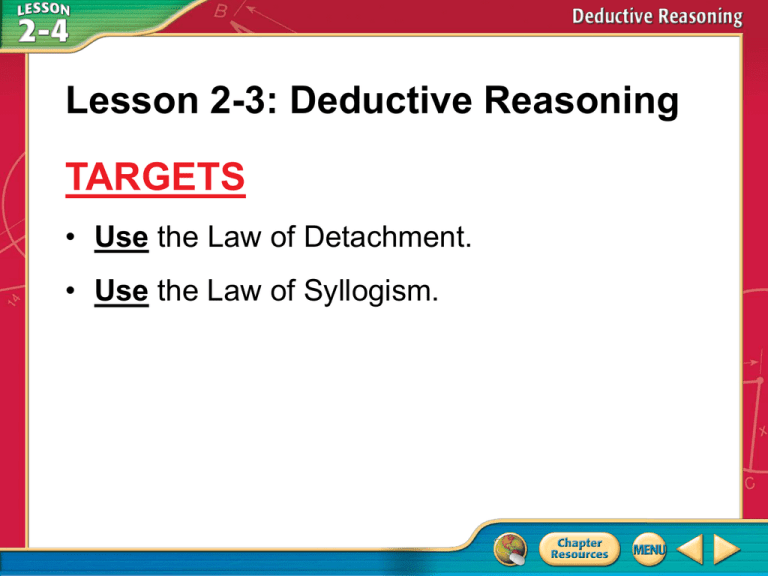
Lesson 2-3: Deductive Reasoning TARGETS • Use the Law of Detachment. • Use the Law of Syllogism. LESSON 2-4: Deductive Reasoning Have you ever tried to convince someone of something using facts and arguments? Deductive Reasoning!!!!!! LESSON 2-4: Deductive Reasoning Deductive Reasoning Uses facts, rules, definitions, or properties to reach logical conclusions **It is very important not to assume anything more than** exactly what is written LESSON 2-4: Deductive Reasoning EXAMPLE 1 Inductive and Deductive Reasoning Determine whether the conclusion is based on inductive or deductive reasoning. A. In Miguel’s town, the month of April has had the most rain for the past 5 years. He thinks that April will have the most rain this year. B. Sandra learned that if it is cloudy at night it will not be as cold in the morning than if there are no clouds at night. Sandra knows it will be cloudy tonight, so she believes it will not be cold tomorrow morning. LESSON 2-4: Deductive Reasoning EXAMPLE 1 Inductive and Deductive Reasoning Determine whether the conclusion is based on inductive or deductive reasoning. C. Every time Kennedy has skipped studying for a science test, she has gotten at least six wrong. Kennedy skipped studying for her science test today, so she concludes that she will get at least six wrong. D. If Cale is late enrolloing for summer school, he will be assessed a late fee of $30. Cale has enrolled late this summer, so he concludes that he will be assessed a late fee of $30. LESSON 2-4: Deductive Reasoning EXAMPLE 2 Use the Law of Detachment Determine whether the conclusion is valid based on the given information. If not, write invalid. Explain your reasoning. A. Given: • If a point is a midpoint of a segment, then it divides the segment into 2 congruent segments. • W is the midpoint of DC. DW WC Conclusion: LESSON 2-4: Deductive Reasoning EXAMPLE 2 Use the Law of Detachment Determine whether the conclusion is valid based on the given information. If not, write invalid. Explain your reasoning. B. Given: • If Billy goes to the gym, he will wear athletic socks.. • Billy is wearing athletic socks. Conclusion: Billy is at the gym. LESSON 2-4: Deductive Reasoning EXAMPLE 3 Judge Conclusions Using Venn Diagrams Determine whether the conclusion is valid based on the given information. If not, write invalid. Explain your reasoning using a Venn diagram. A. Given: • If a boy is in choir, then he is not in band. • Kyle is a boy who is not in band. Conclusion: Kyle is in choir. LESSON 2-4: Deductive Reasoning EXAMPLE 3 Judge Conclusions Using Venn Diagrams Determine whether the conclusion is valid based on the given information. If not, write invalid. Explain your reasoning using a Venn diagram. B. Given: • If a triangle is equilateral, then it is an acute triangle. • The triangle is equilateral. Conclusion: The triangle is acute. LESSON 2-4: Deductive Reasoning EXAMPLE 4 Use the Law of Syllogism Use the Law of Syllogism to determine whether a valid conclusion can be reached from each set of statements. A. (1) If a figure is a square, then it has four right right angles. (2) Figure with four right angles is a rectangle. LESSON 2-4: Deductive Reasoning EXAMPLE 4 Use the Law of Syllogism Use the Law of Syllogism to determine whether a valid conclusion can be reached from each set of statements. B. (1) Perpendicular lines form right angles. (2) The sum of complementary angles equals 90. LESSON 2-4: Deductive Reasoning EXAMPLE 5 Apply Laws of Deductive Reasoning Draw a valid conclusion from the given statements, if possible. Then state whether your conclusion was drawn using the Law of Detachment or the Law of Syllogism. If no valid conclusion can be drawn, write no conclusion and explain your reasoning. Given: If it snows more than 5 inches, school will be closed. It snows 7 inches. LESSON 2-4: Deductive Reasoning EXAMPLE 5 Apply Laws of Deductive Reasoning Draw a valid conclusion from the given statements, if possible. Then state whether your conclusion was drawn using the Law of Detachment or the Law of Syllogism. If no valid conclusion can be drawn, write no valid conclusion and explain your reasoning. Given: (1) If 2 angles form of a linear pair, then they are supplementary. (2) If 2 angles are supplementary, then the sum of the angles equals 180.
